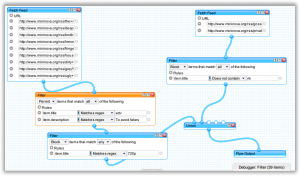The Grey Album Producer Danger Mouse Explains How He Did It
Brian Burton’s ingenious idea to mash-up Beatles’ White Album and Jay–Z’s Black Album fell flat, in my opinion. If the definition of a music mash-up is a “composition created by blending two or more pre-recorded songs, usually by overlaying the vocal track of one song seamlessly over the instrumental track of another,” (Wikipedia.org) then what Burton created is a watered-down version of one. His deconstruction of Beatles’ instrumental and voice tracks transformed Beatles’ music to the level of being unrecognizable. Therefore, he manipulated tracks to his advantage to make the necessary pieces fit, neglecting the artistry and missing the point of a mash-up, which is to combine/mix authentic tracks to produce a brand new, original composition.
There is a long history of mash-ups in music pop culture. According to Wikipedia.org, its roots go back to dance hall culture of late-1960s/early-1970s in Jamaica. In the mid-1970s, DJs in discos were mixing mash-ups with disco songs using loops and tape edits. So, why is it that Brian Burton is getting all the attention and more importantly, why has The Grey Album resonated with so much with his audience? My guess is that in our contemporary, tech driven culture, it is much easier to reach a very large audience through the Internet than we could have reached back in the ‘70s. Also, anyone can create a mash-up because most computers come with some kind of music editing program. We end up mass producing and purging our work out into the nebulous space of the World Wide Web.
In conclusion, I wonder if it is really feasible to combine just two specific albums to create a brand new one and make every song successful. It seems to me that Burton had an idea in his head and was very determined to see that it come to fruition, thus neglecting the artistry of a mash-up. I feel like he has gained notoriety because of the volume of his project not its quality.
1+1+1+1=1 The New Math of Mashups, by Sasha Frere-Jones
This was a very insightful article that clearly illustrates the artistry of creating a mash-up, mash-up’s implications in our pop culture and the legal challenges of sampling copywritten music.
Frere-Jones says that anyone can create a mash-up since we find “new uses for current digital technology, a new iteration of the cause-and-effect relationship behind almost every change in pop-music aesthetics.” In other words, if we are armed with the right technology, why not morph the music you do not like into something that you do? He goes to say that we do not need a distributor because the Internet is our distributor and the bedroom is our record label.
Unfortunately, a moral dilemma arises due to the freedom of the Internet and the availability of copywritten music tracks. Do we have legal rights to play around with someone else’s work and then put our own stamp on it? Is the art of mash-ups a form of piracy? In the hands of today’s tech savvy population, can piracy be avoided and can you blame people for wanting to transformed horrible junk that is put out by some artists into something that is decent and tolerable? At the end of the day, I do think that mash-ups is a form of piracy but only when someone is profiting off their creating without the approval of the artists being sampled.



Comments!